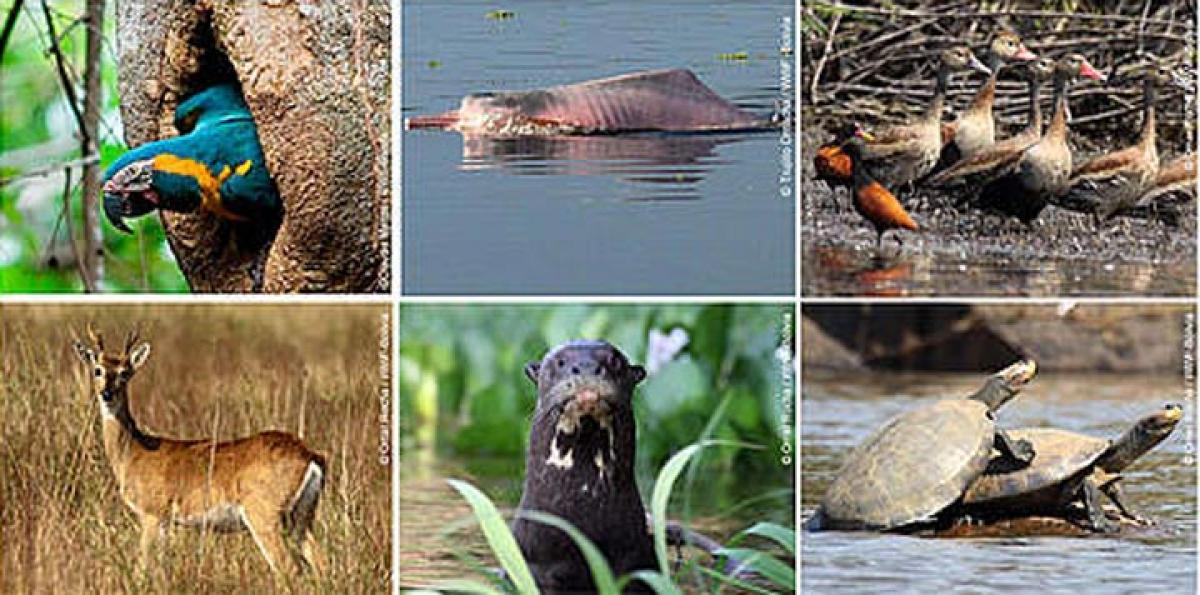Live
- India Urges $1.3 Trillion Annual Climate Support for Developing Nations
- Bad air: 106 shuttle buses, 60 extra Metro trips planned to make Delhiites give up cars
- WHO reports declining monkeypox cases in Congo
- CM Attends Kotideepotsavam on Kartika Purnima
- PKL Season 11: Raiding trio of Devank, Ayan, Sandeep help Patna Pirates rout Bengal Warriorz
- Food waste crisis fuels sustainable practices across APAC food & beverage industry: Report
- AI helps erase racist deed restrictions in California
- ATMIS completes third phase of troops' drawdown in Somalia
- PM Kisan Samman Nidhi scheme bringing smile to Nalanda farmers
- German economy forecast to lag eurozone growth until 2026
Just In

The theme of the World Environment Day, which falls on June 5, this year is “Go wild for life,” which is one of the goals of Sustainable Development Goals (SDG 15). It deals with “Life on Land” and widely calls for global support to combat poaching and trafficking of protected species. It also calls for increasing the capacity of local communities to pursue sustainable livelihood opportunities.
The theme of the World Environment Day, which falls on June 5, this year is “Go wild for life,” which is one of the goals of Sustainable Development Goals (SDG 15). It deals with “Life on Land” and widely calls for global support to combat poaching and trafficking of protected species. It also calls for increasing the capacity of local communities to pursue sustainable livelihood opportunities.
The celebration of World Environment Day is a time to reflect on whether our collective behaviour needs to be modified to address challenges such as climate change and biodiversity loss. Targeting positive impacts based on the Sustainable Development Goals (SDG) 2030 will help preserve the environment and lead to a safer world for all
The celebration of World Environment Day is a time to reflect on whether our collective behaviour needs to be modified to address challenges such as climate change and biodiversity loss. Targeting positive impacts based on the Sustainable Development Goals (SDG) 2030 will help preserve the environment and lead to a safer world for all.
This is in line with the Convention on Biological Diversity (CBD), which came into effect at the Earth Summit in 1992. The CBD has three main goals: conservation of biodiversity, sustainable use of biodiversity, and fair and equitable sharing of benefits arising from genetic resources. The goals of the Earth Summit have made some progress on wildlife conservation after more than two decades.
Nepal can be proud for ‘Zero Poaching’ of rhinos in last two years, which is an inspirational feat. Similarly, there has been an increase in the number of tigers in India and recovery of the population of Tibetan Antelope in China, which were nearly almost extinct. This proves that political will combined with targeting poachers, sharing good practices, and raising awareness, particularly among youth, can help local communities and conservation agencies work together to sustain wildlife populations.
According to a United Nations Report, the estimated value of global imports of legal wildlife products annually increased more than twofold in 2009, from $160 billion to $323 billion. However, the positive balance sheet of regulated achievements has caveats. Estimates suggest that less than a fifth of the wildlife trade is unlawful, this trade has transnational dimensions.
In the Hindu Kush Himalayas (HKH), there is a vast array of wildlife products (food, wool and fur, leather goods, tourist curios and medicines) that are part of an illegal trade across borders, which has the potential to drive species to extinction. Snow leopard skins and tiger bones are frequently seized from smugglers and poachers crossing HKH borders.
Moreover, one of the problems with controlling this trade is the disconnection between global environmental agreements, such as the Convention on International Trade in Endangered Species of Wild Flora and Fauna (CITES), and national laws and implementation capacity.
The ongoing research on good management practices is solidly supportive of the connection between species diversity and the stability of ecosystems. Species richness and genetic diversity enhance the productivity and stability of terrestrial and marine ecosystems and their resistance to invasion by weedy species, as well as agricultural productivity.
Research also reveals that greater species and genetic diversity also reduces the transmission of disease among species. To sum up the long list of contemporary issues, the climate change impacts should also not be ignored , which are threatening the habitat and the water security of wild animals, and much be prepared for the possibility of socio-demographic changes, which may weaken local institutions and community conservation practices.
The landscape approach tested in the Terai Arc Landscape in Nepal and the Kailash Sacred Landscape in China, India and Nepal, and the ‘Human Wildlife Safe System Approach’ being tested in Bhutan, could change the way that we approach wildlife conservation.
Although such an interdisciplinary holistic approach is easier said than done, early models of trans-boundary cooperation such as cross-border meetings between key stakeholders on wildlife themes, common trans-boundary vegetation maps using remote sensing for long-term planning, and common research methodologies are available and can be replicated to secure our biodiversity.
We must act now, as custodians of our mountain biodiversity, which sustains us and our environment, to ensure that this great richness can be enjoyed by future generations.

© 2024 Hyderabad Media House Limited/The Hans India. All rights reserved. Powered by hocalwire.com







